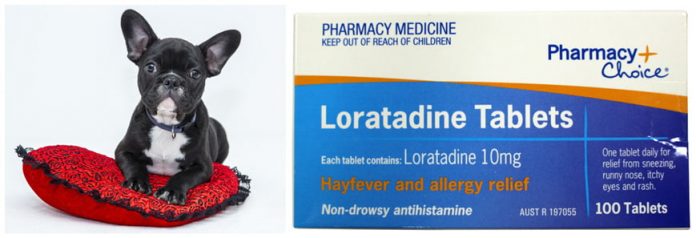
Administering Loratadine to dogs is one of the conventional ways of managing the symptoms of canine allergies. It is safe but did you know that not all vets consider it as the first option for dog allergy? This is because the outcome of antihistamine therapy in canines is not as reliable in pets as it is in humans.
Still, you can find a lot of reviews talking about the efficacy of Loratadine in pets. Many dogs respond very well to this type of antihistamine. Did your vet prescribe it for allergies? Read morein this post about Loratadine for dogs.
What is Loratadine?
Loratadine is a type of second-generation antihistamine. Unlike the first generation of antihistamines, such as diphenhydramine and clemastine, Loratadine has a less sedating effect. This is because it only crosses the blood-brain barrier at a much lower level. Compared to the first generation antihistamines, the effects of Loratadine last longer.
The medicine works by slowing down the activity of histamines, which are the chemical compounds that cause many allergy symptoms. Loratadine, therefore, prevents swelling or any symptom associated with canine allergy. Dogs usually suffer from swelling, itchiness, and reddened skin when there is an overproduction of histamine inside their body.
If you suspect your dog is suffering from allergies, keep an eye for the following symptoms:
- He cannot stop scratching
- He chews his legs and feet
- He has hot spots on his skin
- He has alopecia or hair loss
The causes of allergy widely vary, but the most common allergens in dogs come from food and the environment. If it’s an allergy to food, the skin problems will be accompanied by gastrointestinal problems. So, aside from itching and redness, your pet could also suffer from diarrhea and vomiting.
There are also certain indications that will you what type of allergy hit your dog. When your pet excessively scratches the back of his teal, it is most likely flea allergy. A dog with food allergy tends to scratch his ears and his paws.
Loratadine is often used in treating dog allergies, mainly because it is one of the most affordable options on the market. It is currently available under many different names, but the most popular brand for dogs is Claritin.
The Food and Drug Administration has not approved Claritin for animal use. However, a licensed veterinarian can still legally prescribe it as an “off the label drug” because there is no equivalent of a veterinary formulation to it.
You can purchase it over the counter. However, you still need a vet’s supervision if you are planning to give it to a dog. This is to make sure your dog gets the accurate dosage for his size.
Let your vet know if your pet is currently taking other medications or supplements. There are certain types of drugs that should not be used along with Loratadine. This antihistamine interacts with drugs such as erythromycin and cimetidine. It’s also not a good idea to administer Loratadine if your pet has already taken another antihistamine.
Uses of Loratadine in Dogs
Aside from treating allergy symptoms in canines, Loratadine has a lot more uses for them. Here are some of the ways Loratadine can be helpful:
- Insect stings – if your pet was bitten by an insect or stung by a bee, he will suffer from localized itching of the skin. Antihistamines, such as Loratadine, are often used as first aid for insect bites as they reduce the itching.
- Snake bites – a snake bite can also cause allergic reactions. The best way to deal with it is to seek veterinary help, but in instances when that is not possible, vets recommend administering antihistamines.
- Reactions to blood transfusions – repeated transfusions are normally done to dogs with blood clotting problems. Antihistamines can be administered to limit fever if it is clinically serious.
- Vaccination reactions – standard vaccinations, particularly boosters, commonly cause allergies in dogs. An antihistamine drug may be taken before the vaccination to prevent allergic symptoms.
Loratadine Dosage to Dogs
According to the Valley Vet Hospital, the dosage of Loratadine for dogs should be 5 milligrams once a day for a dog weighing 15 pounds or less. For dogs weighing 15-39 pounds, you can double the daily dose or give him 5 milligrams twice a day. Larger dogs weighing more than 40 pounds can safely take 10 milligrams two times a day.
If you struggle with giving tablets to your dog, try hiding them inside a soft or sticky food. Got a dog who would die for meatballs? Put the pill inside his favorite treat and he might not even notice it! This is actually the best way to trick a dog into taking his pill without him realizing it.
Make sure to only give your dog medicines that are labeled as Claritin or Alavert and not Claritin-D or Alavert D-12 Hour. The active ingredient of the latter ones is pseudoephedrine which is not recommended for canines. The type of Claritin you can only give your pet is the plain one or the one that is formulated for kids.
Claritin-D, Alavert D-12 Hour, and any antihistamine with pseudoephedrine can increase the heart rate of dogs. They could also cause seizures and hyperactivity. The toxic dose will depend on the dog’s size, but for a middle-sized dog, 340 to 400 milligrams of Loratadine is enough to cause death.
In case your pet accidentally swallowed an antihistamine with pseudoephedrine, take him to a veterinary hospital especially if symptoms of distress are present. Your dog should be put on IV fluids to get rid of the drug from his system.
Loratadine is available in both solid and liquid forms. Only the solid form, or those sold as capsules or tablets are safe for dogs. The Loratadine syrup is not recommended for dogs because it may contain alcohol as one of the main ingredients. The alcohol content in the syrup is too much for a dog to handle.
Loratadine Side Effects in Dogs
The most common side effect of Loratadine in dogs is drowsiness. It is normal for your pet to experience dryness of the mouth, increased heart rate, and changes in bowels. The drug can also cause certain behavioral changes in dogs.
During the Loratadine treatment, your pet could also become extremely thirsty. It is important that you monitor his hydration. If you can’t be around all the time, at least make sure that he gets access to clean and fresh water.
In the event that your pet further displays allergic reactions after taking the medication, call your veterinarian right away. Your vet will likely recommend another type of antihistamine for your pet. Based on statistics, only one out of three dogs seem to respond well to Loratadine.
Risks of Giving Loratadine to Dogs
Make sure your medications are all kept in a secure place that is out of your dog’s reach. He might get into it and swallow it. An excessive amount of Loratadine can badly affect your pet’s central nervous system. It can also cause abnormalities in his heart and blood vessels.
Antihistamine poisoning can happen if your dog ingested more than the maximum allowed dosage. If you suspect your pet just ingested a large number of Loratadine tablets, call a pet poison helpline or your veterinarian.
You will be instructed how to perform induced vomiting given that the ingestion took place a couple of hours before. Induced vomiting is no longer advised if the ingestion happened several hours before. Ipecac, an over-the-counter drug and 3% Hydrogen Peroxide are commonly used in inducing vomiting in canines.
The symptoms of Loratadine poisoning in canines are increased and irregular heartbeat, vomiting, and hyperactivity. An intoxicated dog will look confused and may even suffer from seizures.
When Not to Give Loratadine to Dogs
Don’t administer Loratadine to your pet if he is suffering from a liver or kidney disease. It is excreted in the urine and many antihistamines cause liver enzyme elevations. Ask your vet about natural treatments to allergy symptoms if your pet is suffering from liver or kidney problems.
Ask your veterinarian first before administering Loratadine to your pregnant or nursing dog. In humans, the drug is safe to use but because Loratadine is not really intended for animal use, it may have a different effect on dogs.
There are so many natural alternatives to Loratadine out there, but they should also be used with caution. Quercetin, for instance, is a very popular natural antihistamine. It is effective but it should not be administered to pregnant and lactating dogs or those suffering from chronic kidney disease.
The Bottom Line
Loratadine is a safe and effective antihistamine for pets. It is one of the more recent types of drugs used for treating allergy symptoms, both in humans and in dogs. Although it is safer compared to other allergy medications like cortisone, it is still important to get your vet’s consent regarding its use.
Misuse of the product can lead to antihistamine poisoning. The most important thing to consider is that Loratadine may or may not work on your pet. Your vet will likely conduct a trial and error to determine what antihistamine will suit your dog.





















